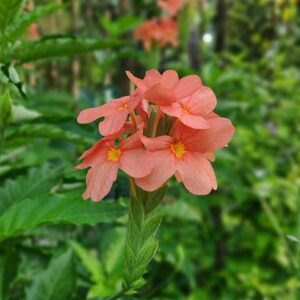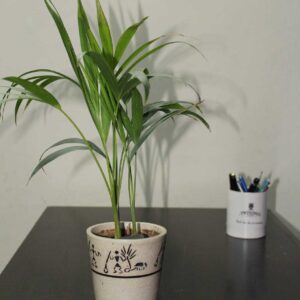Introduction
Pink Syngonium is a popular indoor plant known for its attractive pink and green leaves. It belongs to the Araceae family and is native to tropical regions of Mexico, Central and South America (1).
The plant has heart-shaped leaves that start off as bright pink and gradually turn green as the plant matures. It’s a climbing vine that can grow up to 3-6 feet tall and can be trained to climb a trellis or grown as a trailing plant in a hanging basket.
Click on the headings to read more!
Varieties
There are several varieties of Pink Syngonium, each with its own unique features and characteristics. Here are some popular varieties:
Pink Syngonium
This is the classic Pink Syngonium variety, and one of the most popular houseplants around. Its heart-shaped leaves are a vibrant shade of pink, with green veins and stems. The leaves can grow to be several inches long, and the plant itself can reach up to three feet tall, although it is often kept smaller through pruning.
Pink Syngonium Splash
This variety has pink and green leaves with splashes of white, giving it a more variegated appearance. The leaves are arrow-shaped and can grow up to six inches long. ‘Pink Splash’ is a slightly slower-growing plant than other Pink Syngonium varieties, but it is worth the wait for its unique and eye-catching foliage.
Pink Syngonium Allusion
This variety has lighter pink leaves with a silvery sheen, making it appear more metallic than other Pink Syngonium varieties. The leaves are arrow-shaped and can grow up to six inches long. ‘Pink Allusion’ is a smaller plant, typically reaching a height of only one to two feet, making it an excellent choice for smaller spaces.
Pink Syngonium Neon Pink
As the name suggests, this variety has vibrant, neon pink leaves that are sure to make a statement in any room. The leaves are arrow-shaped and can grow up to six inches long. ‘Neon Pink’ is a fast-growing plant that can quickly fill up a space with its bright and bold foliage.
Pink Syngonium Confetti
This variety has small, speckled leaves that are pink, green, and white, giving it a more playful and whimsical look. The leaves are arrow-shaped and can grow up to four inches long. ‘Confetti’ is a smaller plant that typically grows to be one to two feet tall, making it perfect for use in terrariums or as a desk plant.
Benefits
Aside from being a beautiful and decorative houseplant, Pink Syngonium offers several benefits:
Air-purifying properties:
It helps to purify the air by removing toxins and pollutants such as formaldehyde, benzene, and xylene. This may help to improve the air quality in your home or office.
Stress reduction:
Research has shown that indoor plants can help to reduce stress levels and promote a sense of calm and relaxation. Syngonium Pink’s vibrant colors and attractive foliage can help to create a soothing and calming environment.
Easy to care for:
Syngonium Pink is a low-maintenance plant that is easy to care for and requires minimal attention. This makes it an ideal plant for those who are new to gardening or have limited time to devote to plant care.
Versatile:
This plant can be grown in a variety of settings, including as a trailing plant in a hanging basket, as a climbing plant on a trellis or moss pole, or in a tabletop pot. This makes it a versatile plant that can be used in a variety of indoor spaces.
Low light tolerant:
This plant can tolerate lower light levels, making it a great plant for areas of your home or office that do not receive a lot of natural light.
Plant care
Light:
Pink Syngonium prefers bright, indirect light. Direct sunlight can scorch the leaves, so it’s best to place the plant in a location that receives filtered light or indirect sunlight.
Water:
This plant likes to be kept evenly moist, but not too wet. So, it is advised to water the Pink Syngonium thoroughly once the top inch of soil feels dry to the touch. To avoid root rot, make sure not to let the plant sit in standing water as overwatering can be harmful to the plant.
Humidity:
Syngonium Pink prefers higher humidity levels, but can tolerate lower humidity levels as well. To increase humidity levels for your Pink Syngonium plant, you can either mist the leaves with water or place a humidifier near the plant.
Fertilizer:
Syngonium Pink benefits from regular fertilization during the growing season (spring and summer). For optimal growth, it is recommended to use a water-soluble fertilizer that is balanced in nutrients once a month. This will provide the Pink Syngonium with the necessary nutrients it needs to thrive and maintain its vibrant foliage.
Temperature:
This plant prefers average room temperatures between 60-75°F (15-24°C). Avoid placing the plant in areas with extreme temperature fluctuations or near drafts.
Pruning:
Prune Syngonium Pink to maintain its shape and promote bushier growth. Pinch back the tips of the vines to encourage new growth and remove any yellow or brown leaves.
Potting:
Repot it every 1-2 years in a well-draining potting mix. Choose a pot that is one size larger than the current pot and add fresh potting soil.
Remember that Syngonium Pink is toxic to pets, so keep it out of reach of cats and dogs. With proper care, it can thrive and add beauty to your indoor space.
Propagation
Syngonium Pink can be propagated through stem cuttings. Here are the steps:
Choose a healthy stem:
Look for a stem on the plant that is at least 4-6 inches long and has several leaves.
Cut the stem:
Use a clean, sharp pair of scissors or pruning shears to cut the stem just below a node (the point where a leaf joins the stem). For optimal results, make the cut at a slight angle.
Prepare the cutting:
Remove the bottom 1-2 leaves from the stem, leaving at least 2-3 leaves at the top.
Rooting hormone (optional):
To promote root growth, you can dip the cut end of the stem in rooting hormone. This will increase the chances of successful propagation for your Pink Syngonium plant.
Plant the cutting:
Plant the cutting in a small pot filled with moist, well-draining potting soil. Make a small hole in the soil with your finger or a pencil and insert the cutting. You can press the soil around the cutting to hold it in place.
Water and cover:
Water the cutting thoroughly and cover the pot with a clear plastic bag or a plastic dome to create a humid environment. So that it will help the cutting to retain moisture and promote root growth.
Place in a bright, indirect light:
Place the pot in a bright, indirect light. Direct sunlight can scorch the leaves and hinder root growth.
Monitor and care:
Ensure to monitor the soil moisture frequently and provide water as required, maintaining the soil moist but avoiding waterlogging. After a few weeks, the cutting should start to produce new growth and roots.
Once the cutting has produced a good root system, it can be transplanted into a larger pot or shared with friends and family. With proper care, the new plant should grow into a healthy and thriving Syngonium Pink.



